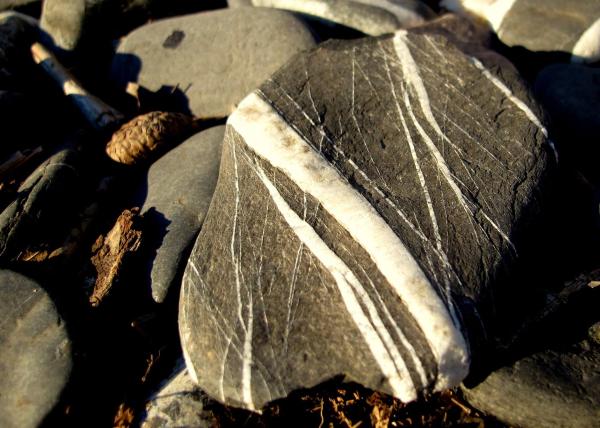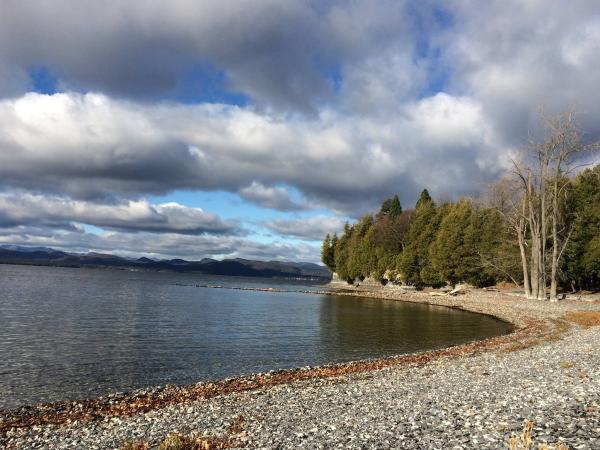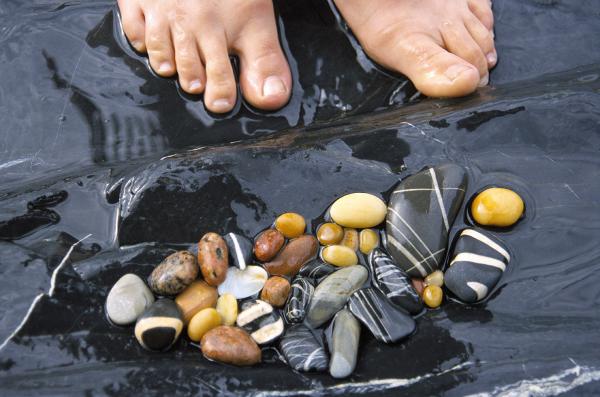Thank you for informative information. I always wondered about the white streaks myself and you answered everything!! Great read!
Champlain beach rocks
Every summer for the past 20 years I’ve enjoyed these flat, dark gray stones streaked with unmistakable white lines. They're such a part of Lake Champlain beaches. But I’ve always wondered “What’s their story?” Why are they here?
And even more basic, “What are they called?”
Until this summer, I’d never stopped to find out.
The stones are Iberville shale – a name that comes from the Quebec town where the shale was discovered by Western geologists. It’s a thinly layered, sedimentary rock that was formed from marine silt deposited roughly 500 to 440 million years ago.
(The years of geologic time are mind-boggling. I think that’s one reason people sometimes struggle with discussions geologic. To make it real for students on our school program, Stories in Stone, we have students pace off significant geologic events, with one step equaling 20 million years!)
Iberville Shale was created during the Ordovician period, when almost all of the earth north of the tropics was ocean. The silt deposited deep in these ocean waters became shale as it hardened and compacted over time. Believe it or not, it’s much “younger” than most other sedimentary rocks in the Champlain Valley, which date back 600-500 million years!
And the tell-tale white stripes? They’re veins of mineral calcite. They were formed by powerful compressing forces that drove calcium carbonate in the water to coalesce into mineral calcite.
Newly formed volcanic islands along the edge of this landmass were also part of the collision fray. They further uplifted the mountains, and created faults and folds in the sedimentary rocks caught between the land masses.
But, in fact, visitors cross the Champlain Thrust every time they leave Shelburne Farms through the front gate! It's not as easily visible, but you span about ~175 million years as you cross Harbor Road. (Notice the reddish Monkton Formation in the outcrop at the intersection of Bay Road and Harbor Road).
So now we know the scientific story -- much abridged -- behind the white-streaked rocks on Shelburne Farms’ shoreline. But I must confess, I found all the geology reading pretty slow going. (I couldn’t help wishing there were more people in it!)
So I asked our educators, Justin Frawley and Ryan Morra, how they bring geology to life for students. They both quickly responded, “It’s all about bringing them to the shore.”
“When you’re at the beach and you can see the folds and twists in the outcroppings, you really get a feel for the level of force needed to bend rock,” explained Ryan. “And it’s just beautiful,” he adds.
Justin chimes in, “When I was with students the other day, we came across some cliff rock that had recently slumped into the lake. It makes kids realize that geology didn’t just shape our past; it’s still shaping our future. It’s happening now.”
We also have the "Rocks to Cheese" story that we share with students, campers, and others. The story traces the journey of calcium from the ancient Champlain Valley rocks (like the Iberville shale), to the soil, to the pasture grasses and cows, and, ultimately, into the milk we drink or cheese we eat.
So Justin is right. Geology is happening now. Think about it next time you take a bite of cheddar...or skip a rock.
**************
Want to learn more about the Champlain Valley and Vermont geology? Find a program on our calendar.



